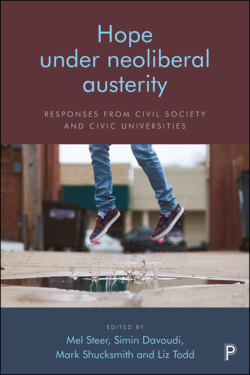Читать книгу Hope Under Neoliberal Austerity - Группа авторов - Страница 8
На сайте Литреса книга снята с продажи.
ОглавлениеForeword
Lord Kerslake
The ‘austerity decade’ between 2010 and 2020 was a unique period in British economic, political and social history. Prior to that, public spending had continued to grow steadily with the development of the state’s role in protecting and promoting the well-being of its citizens, albeit with periodic reining in during economic crises. Even in the Thatcher government, the cuts were borne most by capital expenditure, notably, housing investment, rather than day-to-day spending on services.
The austerity programme introduced by the Conservative–Liberal Democrat Coalition in 2010 represented a sharp reversal of that trend. It was born out of the financial crisis of 2008 – essentially a banking crisis – the cost of responding to which had seriously impacted the country’s finances. This was common to most developed nations but was particularly significant in the UK due to the high proportion the financial services sector made up of its economy.
For the then Chancellor George Osborne, austerity was both a political and an economic agenda. The sense of crisis and urgency created – we had ‘maxed out’ on our credit cards and were heading towards becoming another Greece – served to underline a political argument that the previous Labour government had left the country in a financial mess and were not to be trusted on the economy. The reality was more complex than this, of course, but the political argument stuck.
There is an irony that, ten years on, the need to respond to another global crisis – this time, a health one – has resulted in ballooning deficits and total debt exceeding £2 trillion, compared to £1.2 trillion in 2010. Austerity temporarily reduced the rate of growth of our debt rather than paying it down.
The economic impact of austerity was arguably self defeating. In a period when demand and confidence in the global economy was low, severely reducing public spending simultaneously across the developed world added to the challenge of low growth and reduced government revenues. The ‘expansionary fiscal contraction’ vaunted by the Chancellor turned out to be a recipe for economic stagnation and led to an easing of austerity and an extension of the timescales to reduce the deficit.
Some, including former Prime Minister David Cameron, have argued that the scale of the spending reductions was not that great and the impact of austerity has been overstated. There is no doubting, though, the massive impact on local authority spending, which fell by a quarter, and the impact that this had on local communities. The reduction was even more acutely felt because of the growing demands on the adult and children’s care budgets, which together make up over half of local authority spending. The consequential impact on other services – leisure, the public realm, early years and so on – was proportionately much greater.
Deprived communities suffered a triple whammy. Being more dependent on government grant meant that the scale of the cuts was even greater. At the same time, their economies were much slower to recover from the effects of the Great Depression than other, more affluent areas. The significant reductions to benefits also had a disproportionate effect.
This timely and important book tells the story of austerity from the perspective of a particular place. There is much to learn from this comprehensive and rigorous piece of work. While the story is a tough one, there are also great positives in the way that the community responded to this enormous challenge. Particularly positive is the role of the university, which fully lived up to its civic role. Universities were fortunate to be spared the full impact of austerity – this was visited on their students in the form of significantly higher fees and loans. That story has still to be played out. Some universities took this as a sign of their intrinsic importance and invested the additional funding generated solely in themselves. Others, such as Newcastle, who were more enlightened, recognised the importance of maintaining the fabric of their local communities and invested in supporting them. I was very pleased to chair the Civic University Commission in 2019, which explored this vital civic role. Professor John Goddard was my deputy and a very valued contributor.
The timeliness of this book lies in the choices confronting the current government in dealing with the cost of COVID-19. The Prime Minister has set his face against another round of austerity but there are powerful political voices on his own side calling for just this instead of the tax rises being mooted by his Chancellor Rishi Sunak. The key decision-makers in government would do well to read this book before making their final decisions.
